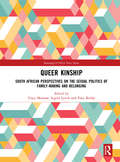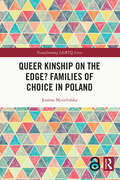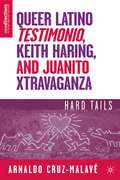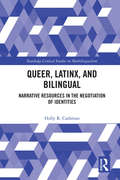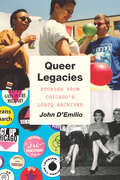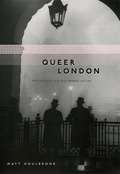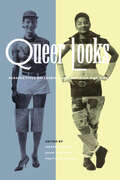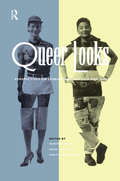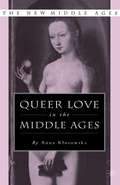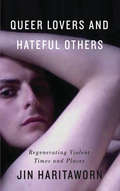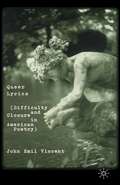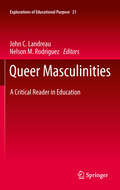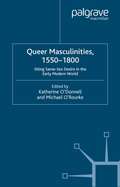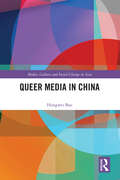- Table View
- List View
Queer Kinship: South African Perspectives on the Sexual politics of Family-making and Belonging (Routledge/UNISA Press Series)
by Vasu Reddy Racy Morison Ingrid LynchWhat makes kinship queer? This collection from leading and emerging thinkers in gender and sexualities interrogates the politics of belonging, shining a light on the outcasts, rebels, and pioneers. Queer Kinship brings together an array of thought-provoking perspectives on what it means to love and be loved, to ‘do family’ and to belong in the South African context. The collection includes a number of different topic areas, disciplinary approaches, and theoretical lenses on familial relations, reproduction, and citizenship. The text amplifies the voices of those who are bending, breaking, and remaking the rules of being and belonging. Photo-essays and artworks offer moving glimpses into the new life worlds being created in and among the ‘normal’ and the mundane. Taken as a whole, this text offers a critical and intersectional perspective that addresses some important gaps in the scholarship on kinship and families. Queer Kinship makes an innovative contribution to international studies in kinship, gender, and sexualities. It will be a valuable resource to scholars, students, and activists working in these areas.
Queer Kinship on the Edge? Families of Choice in Poland (Transforming LGBTQ Lives)
by Joanna MizielińskaQueer Kinship on the Edge explores ways in which queer families from Central and Easter Europe complicate the mainstream picture of queer kinship and families researched in the Anglo-American contexts. The book presents findings from under-represented localities as a starting point to query some of the expectations about queer kinship and to provide insights on the scale and nature of queer kinship in diverse geo-political locations and the complexities of lived experiences of queer families. Drawing on on rich qualitative multi-method study to address the gap in queer kinship studies which tend to exclude Polish or wider Central and Eastern perspectives, it offers a multi-dimensional picture of ‘families of choice’ improving sensitivity towards differences in queer kinship studies. Through case studies and interviews with diverse members of queer families (i.e. queer parents, their children) and their families of origin (parents and siblings) the book looks at queer domesticity, practices of care, defining and displaying families, queer parenthood familial homophobia, and interpersonal relationships through the life-course. This study is suitable for those interested in LGBT Studies, Sexuality Studies, Kinship and Eastern European Studies.
Queer Kinship on the Edge? Families of Choice in Poland (Transforming LGBTQ Lives)
by Joanna MizielińskaQueer Kinship on the Edge explores ways in which queer families from Central and Easter Europe complicate the mainstream picture of queer kinship and families researched in the Anglo-American contexts. The book presents findings from under-represented localities as a starting point to query some of the expectations about queer kinship and to provide insights on the scale and nature of queer kinship in diverse geo-political locations and the complexities of lived experiences of queer families. Drawing on on rich qualitative multi-method study to address the gap in queer kinship studies which tend to exclude Polish or wider Central and Eastern perspectives, it offers a multi-dimensional picture of ‘families of choice’ improving sensitivity towards differences in queer kinship studies. Through case studies and interviews with diverse members of queer families (i.e. queer parents, their children) and their families of origin (parents and siblings) the book looks at queer domesticity, practices of care, defining and displaying families, queer parenthood familial homophobia, and interpersonal relationships through the life-course. This study is suitable for those interested in LGBT Studies, Sexuality Studies, Kinship and Eastern European Studies.
Queer Latino Testimonio, Keith Haring, and Juanito Xtravaganza: Hard Tails (New Directions in Latino American Cultures)
by A. Cruz-MalavéIn the tradition of the Latin American testimonio, this is the story of Juan Rivera, a.k.a. Juanito Xtravaganza, a Latino runaway youth who ends up homeless in the streets of New York in the late 70s and becomes partner of the internationally famous 1980s Pop artist Keith Haring during some of the most frenetically productive years of his brief life, as told to the author and retold by him. A hybrid text - part testimonio, part linguistic and cultural analysis, and part art criticism - this is also a history of New York Latino neighborhoods during this period of devastating disinvestment and gentrification, as well as a personal, heart-felt meditation on the art of listening and the ethical limits of representing queer Latino lives.
Queer, Latinx, and Bilingual: Narrative Resources in the Negotiation of Identities (Routledge Critical Studies in Multilingualism)
by Holly CashmanShortlisted for the 2018 BAAL Book Prize This book is a sociolinguistic ethnography of LGBT Mexicans/Latinxs in Phoenix, Arizona, a major metropolitan area in the U.S. Southwest. The main focus of the book is to examine participants’ conceptions of their ethnic and sexual identities and how identities influence (and are influenced by) language practices. This book explores the intersubjective construction and negotiation of identities among queer Mexicans/Latinxs, paying attention to how identities are co-constructed in the interview setting in coming out narratives and in narratives of silence. The book destabilizes the dominant narrative on language maintenance and shift in sociolinguistics, much of which relies on a (heterosexual) family-based model of intergenerational language transmission, by bringing those individuals often at the margin of the family (LGBTQ members) to the center of the analysis. It contributes to the queering of bilingualism and Spanish in the U.S., not only by including a previously unstudied subgroup (LGBTQ people), but also by providing a different lens through which to view the diverse language and identity practices of U.S. Mexicans/Latinxs. This book addresses this exclusion and makes a significant contribution to the study of bilingualism and multilingualism by bringing LGBTQ Latinas/os to the center of the analysis.
Queer, Latinx, and Bilingual: Narrative Resources in the Negotiation of Identities (Routledge Critical Studies in Multilingualism)
by Holly CashmanShortlisted for the 2018 BAAL Book Prize This book is a sociolinguistic ethnography of LGBT Mexicans/Latinxs in Phoenix, Arizona, a major metropolitan area in the U.S. Southwest. The main focus of the book is to examine participants’ conceptions of their ethnic and sexual identities and how identities influence (and are influenced by) language practices. This book explores the intersubjective construction and negotiation of identities among queer Mexicans/Latinxs, paying attention to how identities are co-constructed in the interview setting in coming out narratives and in narratives of silence. The book destabilizes the dominant narrative on language maintenance and shift in sociolinguistics, much of which relies on a (heterosexual) family-based model of intergenerational language transmission, by bringing those individuals often at the margin of the family (LGBTQ members) to the center of the analysis. It contributes to the queering of bilingualism and Spanish in the U.S., not only by including a previously unstudied subgroup (LGBTQ people), but also by providing a different lens through which to view the diverse language and identity practices of U.S. Mexicans/Latinxs. This book addresses this exclusion and makes a significant contribution to the study of bilingualism and multilingualism by bringing LGBTQ Latinas/os to the center of the analysis.
Queer Legacies: Stories from Chicago’s LGBTQ Archives
by John D'EmilioThe variety of LGBTQ life in Chicago is too abundant and too diverse to be contained in a single place. But since 1981, the Gerber/Hart Library and Archives has striven to do just that, amassing a wealth of records related to the city’s gay, lesbian, bisexual, transgender, and queer-identified people and organizations. In Queer Legacies, John D’Emilio—a pioneering scholar in the field—digs deep into Gerber/Hart’s collection to unearth a kaleidoscopic look at the communities built by generations of LGBTQ people. Excavated from one of the country’s most important, yet overlooked, LGBTQ archives, D’Emilio’s entertaining and enthusiastic essays range in focus from politics and culture to social life, academia, and religion. He gives readers an inclusive and personal look at fifty years of a national fight for visibility, recognition, and equality led by LGBTQ Americans who, quite literally, made history. In these troubled times, it will surely inspire a new generation of scholars and activists.
Queer Legacies: Stories from Chicago’s LGBTQ Archives
by John D'EmilioThe variety of LGBTQ life in Chicago is too abundant and too diverse to be contained in a single place. But since 1981, the Gerber/Hart Library and Archives has striven to do just that, amassing a wealth of records related to the city’s gay, lesbian, bisexual, transgender, and queer-identified people and organizations. In Queer Legacies, John D’Emilio—a pioneering scholar in the field—digs deep into Gerber/Hart’s collection to unearth a kaleidoscopic look at the communities built by generations of LGBTQ people. Excavated from one of the country’s most important, yet overlooked, LGBTQ archives, D’Emilio’s entertaining and enthusiastic essays range in focus from politics and culture to social life, academia, and religion. He gives readers an inclusive and personal look at fifty years of a national fight for visibility, recognition, and equality led by LGBTQ Americans who, quite literally, made history. In these troubled times, it will surely inspire a new generation of scholars and activists.
Queer Legacies: Stories from Chicago’s LGBTQ Archives
by John D'EmilioThe variety of LGBTQ life in Chicago is too abundant and too diverse to be contained in a single place. But since 1981, the Gerber/Hart Library and Archives has striven to do just that, amassing a wealth of records related to the city’s gay, lesbian, bisexual, transgender, and queer-identified people and organizations. In Queer Legacies, John D’Emilio—a pioneering scholar in the field—digs deep into Gerber/Hart’s collection to unearth a kaleidoscopic look at the communities built by generations of LGBTQ people. Excavated from one of the country’s most important, yet overlooked, LGBTQ archives, D’Emilio’s entertaining and enthusiastic essays range in focus from politics and culture to social life, academia, and religion. He gives readers an inclusive and personal look at fifty years of a national fight for visibility, recognition, and equality led by LGBTQ Americans who, quite literally, made history. In these troubled times, it will surely inspire a new generation of scholars and activists.
Queer Legacies: Stories from Chicago’s LGBTQ Archives
by John D'EmilioThe variety of LGBTQ life in Chicago is too abundant and too diverse to be contained in a single place. But since 1981, the Gerber/Hart Library and Archives has striven to do just that, amassing a wealth of records related to the city’s gay, lesbian, bisexual, transgender, and queer-identified people and organizations. In Queer Legacies, John D’Emilio—a pioneering scholar in the field—digs deep into Gerber/Hart’s collection to unearth a kaleidoscopic look at the communities built by generations of LGBTQ people. Excavated from one of the country’s most important, yet overlooked, LGBTQ archives, D’Emilio’s entertaining and enthusiastic essays range in focus from politics and culture to social life, academia, and religion. He gives readers an inclusive and personal look at fifty years of a national fight for visibility, recognition, and equality led by LGBTQ Americans who, quite literally, made history. In these troubled times, it will surely inspire a new generation of scholars and activists.
Queer London: Perils and Pleasures in the Sexual Metropolis, 1918-1957 (Chicago Series on Sexuality, History, and Society)
by Matt HoulbrookIn August 1934, young Cyril L. wrote to his friend Billy about all the exciting men he had met, the swinging nightclubs he had visited, and the vibrant new life he had forged for himself in the big city. He wrote, "I have only been queer since I came to London about two years ago, before then I knew nothing about it." London, for Cyril, meant boundless opportunities to explore his newfound sexuality. But his freedom was limite: he was soon arrested, simply for being in a club frequented by queer men. Cyril's story is Matt Houlbrook's point of entry into the queer worlds of early twentieth-century London. Drawing on previously unknown sources, from police reports and newspaper exposés to personal letters, diaries, and the first queer guidebook ever written, Houlbrook here explores the relationship between queer sexualities and modern urban culture that we take for granted today. He revisits the diverse queer lives that took hold in London's parks and streets; its restaurants, pubs, and dancehalls; and its Turkish bathhouses and hotels—as well as attempts by municipal authorities to control and crack down on those worlds. He also describes how London shaped the culture and politics of queer life—and how London was in turn shaped by the lives of queer men. Ultimately, Houlbrook unveils the complex ways in which men made sense of their desires and who they were. In so doing, he mounts a sustained challenge to conventional understandings of the city as a place of sexual liberation and a unified queer culture. A history remarkable in its complexity yet intimate in its portraiture, Queer London is a landmark work that redefines queer urban life in England and beyond. “A ground-breaking work. While middle-class lives and writing have tended to compel the attention of most historians of homosexuality, Matt Houlbrook has looked more widely and found a rich seam of new evidence. It has allowed him to construct a complex, compelling account of interwar sexualities and to map a new, intimate geography of London.”—Matt Cook, The Times Higher Education Supplement Winner of History Today’s Book of the Year Award, 2006
Queer London: Perils and Pleasures in the Sexual Metropolis, 1918-1957 (Chicago Series on Sexuality, History, and Society)
by Matt HoulbrookIn August 1934, young Cyril L. wrote to his friend Billy about all the exciting men he had met, the swinging nightclubs he had visited, and the vibrant new life he had forged for himself in the big city. He wrote, "I have only been queer since I came to London about two years ago, before then I knew nothing about it." London, for Cyril, meant boundless opportunities to explore his newfound sexuality. But his freedom was limite: he was soon arrested, simply for being in a club frequented by queer men. Cyril's story is Matt Houlbrook's point of entry into the queer worlds of early twentieth-century London. Drawing on previously unknown sources, from police reports and newspaper exposés to personal letters, diaries, and the first queer guidebook ever written, Houlbrook here explores the relationship between queer sexualities and modern urban culture that we take for granted today. He revisits the diverse queer lives that took hold in London's parks and streets; its restaurants, pubs, and dancehalls; and its Turkish bathhouses and hotels—as well as attempts by municipal authorities to control and crack down on those worlds. He also describes how London shaped the culture and politics of queer life—and how London was in turn shaped by the lives of queer men. Ultimately, Houlbrook unveils the complex ways in which men made sense of their desires and who they were. In so doing, he mounts a sustained challenge to conventional understandings of the city as a place of sexual liberation and a unified queer culture. A history remarkable in its complexity yet intimate in its portraiture, Queer London is a landmark work that redefines queer urban life in England and beyond. “A ground-breaking work. While middle-class lives and writing have tended to compel the attention of most historians of homosexuality, Matt Houlbrook has looked more widely and found a rich seam of new evidence. It has allowed him to construct a complex, compelling account of interwar sexualities and to map a new, intimate geography of London.”—Matt Cook, The Times Higher Education Supplement Winner of History Today’s Book of the Year Award, 2006
Queer London: Perils and Pleasures in the Sexual Metropolis, 1918-1957 (Chicago Series on Sexuality, History, and Society)
by Matt HoulbrookIn August 1934, young Cyril L. wrote to his friend Billy about all the exciting men he had met, the swinging nightclubs he had visited, and the vibrant new life he had forged for himself in the big city. He wrote, "I have only been queer since I came to London about two years ago, before then I knew nothing about it." London, for Cyril, meant boundless opportunities to explore his newfound sexuality. But his freedom was limite: he was soon arrested, simply for being in a club frequented by queer men. Cyril's story is Matt Houlbrook's point of entry into the queer worlds of early twentieth-century London. Drawing on previously unknown sources, from police reports and newspaper exposés to personal letters, diaries, and the first queer guidebook ever written, Houlbrook here explores the relationship between queer sexualities and modern urban culture that we take for granted today. He revisits the diverse queer lives that took hold in London's parks and streets; its restaurants, pubs, and dancehalls; and its Turkish bathhouses and hotels—as well as attempts by municipal authorities to control and crack down on those worlds. He also describes how London shaped the culture and politics of queer life—and how London was in turn shaped by the lives of queer men. Ultimately, Houlbrook unveils the complex ways in which men made sense of their desires and who they were. In so doing, he mounts a sustained challenge to conventional understandings of the city as a place of sexual liberation and a unified queer culture. A history remarkable in its complexity yet intimate in its portraiture, Queer London is a landmark work that redefines queer urban life in England and beyond. “A ground-breaking work. While middle-class lives and writing have tended to compel the attention of most historians of homosexuality, Matt Houlbrook has looked more widely and found a rich seam of new evidence. It has allowed him to construct a complex, compelling account of interwar sexualities and to map a new, intimate geography of London.”—Matt Cook, The Times Higher Education Supplement Winner of History Today’s Book of the Year Award, 2006
Queer London: Perils and Pleasures in the Sexual Metropolis, 1918-1957 (Chicago Series on Sexuality, History, and Society)
by Matt HoulbrookIn August 1934, young Cyril L. wrote to his friend Billy about all the exciting men he had met, the swinging nightclubs he had visited, and the vibrant new life he had forged for himself in the big city. He wrote, "I have only been queer since I came to London about two years ago, before then I knew nothing about it." London, for Cyril, meant boundless opportunities to explore his newfound sexuality. But his freedom was limite: he was soon arrested, simply for being in a club frequented by queer men. Cyril's story is Matt Houlbrook's point of entry into the queer worlds of early twentieth-century London. Drawing on previously unknown sources, from police reports and newspaper exposés to personal letters, diaries, and the first queer guidebook ever written, Houlbrook here explores the relationship between queer sexualities and modern urban culture that we take for granted today. He revisits the diverse queer lives that took hold in London's parks and streets; its restaurants, pubs, and dancehalls; and its Turkish bathhouses and hotels—as well as attempts by municipal authorities to control and crack down on those worlds. He also describes how London shaped the culture and politics of queer life—and how London was in turn shaped by the lives of queer men. Ultimately, Houlbrook unveils the complex ways in which men made sense of their desires and who they were. In so doing, he mounts a sustained challenge to conventional understandings of the city as a place of sexual liberation and a unified queer culture. A history remarkable in its complexity yet intimate in its portraiture, Queer London is a landmark work that redefines queer urban life in England and beyond. “A ground-breaking work. While middle-class lives and writing have tended to compel the attention of most historians of homosexuality, Matt Houlbrook has looked more widely and found a rich seam of new evidence. It has allowed him to construct a complex, compelling account of interwar sexualities and to map a new, intimate geography of London.”—Matt Cook, The Times Higher Education Supplement Winner of History Today’s Book of the Year Award, 2006
Queer London: Perils and Pleasures in the Sexual Metropolis, 1918-1957 (Chicago Series on Sexuality, History, and Society)
by Matt HoulbrookIn August 1934, young Cyril L. wrote to his friend Billy about all the exciting men he had met, the swinging nightclubs he had visited, and the vibrant new life he had forged for himself in the big city. He wrote, "I have only been queer since I came to London about two years ago, before then I knew nothing about it." London, for Cyril, meant boundless opportunities to explore his newfound sexuality. But his freedom was limite: he was soon arrested, simply for being in a club frequented by queer men. Cyril's story is Matt Houlbrook's point of entry into the queer worlds of early twentieth-century London. Drawing on previously unknown sources, from police reports and newspaper exposés to personal letters, diaries, and the first queer guidebook ever written, Houlbrook here explores the relationship between queer sexualities and modern urban culture that we take for granted today. He revisits the diverse queer lives that took hold in London's parks and streets; its restaurants, pubs, and dancehalls; and its Turkish bathhouses and hotels—as well as attempts by municipal authorities to control and crack down on those worlds. He also describes how London shaped the culture and politics of queer life—and how London was in turn shaped by the lives of queer men. Ultimately, Houlbrook unveils the complex ways in which men made sense of their desires and who they were. In so doing, he mounts a sustained challenge to conventional understandings of the city as a place of sexual liberation and a unified queer culture. A history remarkable in its complexity yet intimate in its portraiture, Queer London is a landmark work that redefines queer urban life in England and beyond. “A ground-breaking work. While middle-class lives and writing have tended to compel the attention of most historians of homosexuality, Matt Houlbrook has looked more widely and found a rich seam of new evidence. It has allowed him to construct a complex, compelling account of interwar sexualities and to map a new, intimate geography of London.”—Matt Cook, The Times Higher Education Supplement Winner of History Today’s Book of the Year Award, 2006
Queer London: Perils and Pleasures in the Sexual Metropolis, 1918-1957 (Chicago Series on Sexuality, History, and Society)
by Matt HoulbrookIn August 1934, young Cyril L. wrote to his friend Billy about all the exciting men he had met, the swinging nightclubs he had visited, and the vibrant new life he had forged for himself in the big city. He wrote, "I have only been queer since I came to London about two years ago, before then I knew nothing about it." London, for Cyril, meant boundless opportunities to explore his newfound sexuality. But his freedom was limite: he was soon arrested, simply for being in a club frequented by queer men. Cyril's story is Matt Houlbrook's point of entry into the queer worlds of early twentieth-century London. Drawing on previously unknown sources, from police reports and newspaper exposés to personal letters, diaries, and the first queer guidebook ever written, Houlbrook here explores the relationship between queer sexualities and modern urban culture that we take for granted today. He revisits the diverse queer lives that took hold in London's parks and streets; its restaurants, pubs, and dancehalls; and its Turkish bathhouses and hotels—as well as attempts by municipal authorities to control and crack down on those worlds. He also describes how London shaped the culture and politics of queer life—and how London was in turn shaped by the lives of queer men. Ultimately, Houlbrook unveils the complex ways in which men made sense of their desires and who they were. In so doing, he mounts a sustained challenge to conventional understandings of the city as a place of sexual liberation and a unified queer culture. A history remarkable in its complexity yet intimate in its portraiture, Queer London is a landmark work that redefines queer urban life in England and beyond. “A ground-breaking work. While middle-class lives and writing have tended to compel the attention of most historians of homosexuality, Matt Houlbrook has looked more widely and found a rich seam of new evidence. It has allowed him to construct a complex, compelling account of interwar sexualities and to map a new, intimate geography of London.”—Matt Cook, The Times Higher Education Supplement Winner of History Today’s Book of the Year Award, 2006
Queer Looks: Perspectives On Lesbian And Gay Film And Video
by Martha Gever Pratibha Parmar John GreysonQueer Looks is a collection of writing by video artists, filmmakers, and critics which explores the recent explosion of lesbian and gay independent media culture. A compelling compilation of artists' statements and critical theory, producer interviews and image-text works, this anthology demonstrates the vitality of queer artists under attack and fighting back. Each maker and writer deploys a surprising array of techniques and tactics, negotiating the difficult terrain between street pragmatism and theoretical inquiry, finding voices rich in chutzpah and subtlety. From guerilla Super-8 in Manila to AIDS video activism in New York, Queer Looks zooms in on this very queer place in media culture, revealing a wealth of strategies, a plurality of aesthetics, and an artillary of resistances.
Queer Looks
by Martha Gever Pratibha Parmar John GreysonQueer Looks is a collection of writing by video artists, filmmakers, and critics which explores the recent explosion of lesbian and gay independent media culture. A compelling compilation of artists' statements and critical theory, producer interviews and image-text works, this anthology demonstrates the vitality of queer artists under attack and fighting back. Each maker and writer deploys a surprising array of techniques and tactics, negotiating the difficult terrain between street pragmatism and theoretical inquiry, finding voices rich in chutzpah and subtlety. From guerilla Super-8 in Manila to AIDS video activism in New York, Queer Looks zooms in on this very queer place in media culture, revealing a wealth of strategies, a plurality of aesthetics, and an artillary of resistances.
Queer Love in the Middle Ages (The New Middle Ages)
by Anna Klosowska RobertsQueer Love in the Middle Ages points out queer themes in the works of the French canon, including Perceval , the Romance of the Rose and the Roman d'Eneas . It brings out less known works that prominently feature same-sex themes: Yde and Olive , a romance with a cross-dressed heroine who marries a princess; and many others. The book combines an interest in contemporary French theory (Kristeva, Barthes, psychoanalysis) with a close reading of medieval texts. It discusses important recent publications in pre-modern queer studies in the US. It is the first major contribution to queer studies in medieval French literature.
Queer Lovers and Hateful Others: Regenerating Violent Times and Places (Decolonial Studies, Postcolonial Horizons)
by Jin HaritawornQueer subjects have become acceptable in society only through being cast in the shadow of the new folk devil, the 'homophobic migrant' who is rendered by society as hateful and disposable. *BR**BR*This book explores this concept of 'queer regeneration'. Queerness has entered a transitional phase as it becomes co-opted by neoliberalism to make punishment and neglect appear as signs of care and love for diversity. To understand this transition, Jin Haritaworn looks at the environments in which queer bodies have become worthy of protection, discussing the everyday erasures that shape life in the inner city (focusing on Berlin), and how queer activists actively seek out and dispel the myths of sites of nostalgia for the 'invented traditions' of women-and-gay-friendliness.*BR**BR*The author explores a rich archive of media, arts, policy and activism, including posters, newspaper reports, hate crime action plans, urban projects, psychological studies, demonstrations, kiss-ins, political speeches and films. Through these sources, the relationships between Islamaphobia, racism within Europe and the United States, and the global war on terror serves to reinforce the politics of homonationalism.
Queer Lovers and Hateful Others: Regenerating Violent Times and Places (Decolonial Studies, Postcolonial Horizons)
by Jin HaritawornQueer subjects have become acceptable in society only through being cast in the shadow of the new folk devil, the 'homophobic migrant' who is rendered by society as hateful and disposable. *BR**BR*This book explores this concept of 'queer regeneration'. Queerness has entered a transitional phase as it becomes co-opted by neoliberalism to make punishment and neglect appear as signs of care and love for diversity. To understand this transition, Jin Haritaworn looks at the environments in which queer bodies have become worthy of protection, discussing the everyday erasures that shape life in the inner city (focusing on Berlin), and how queer activists actively seek out and dispel the myths of sites of nostalgia for the 'invented traditions' of women-and-gay-friendliness.*BR**BR*The author explores a rich archive of media, arts, policy and activism, including posters, newspaper reports, hate crime action plans, urban projects, psychological studies, demonstrations, kiss-ins, political speeches and films. Through these sources, the relationships between Islamaphobia, racism within Europe and the United States, and the global war on terror serves to reinforce the politics of homonationalism.
Queer Lyrics: Difficulty and Closure in American Poetry
by J. VincentQueer Lyrics fills a gap in queer studies: the lyric, as poetic genre, has never been directly addressed by queer theory. Vincent uses formal concerns, difficulty and closure, to discuss innovations specific to queer American poets. He traces a genealogy based on these queer techniques from Whitman, through Crane and Moore, to Ashbery and Spicer. Queer Lyrics considers the place of form in queer theory, while opening new vistas on the poetry of these seminal figures.
Queer Masculinities: A Critical Reader in Education (Explorations of Educational Purpose #21)
by John C. Landreau and Nelson M. RodriguezQueer Masculinities: A Critical Reader in Education is a substantial addition to the discussion of queer masculinities, of the interplay between queer masculinities and education, and to the political gender discourse as a whole. Enriching the discourse of masculinity politics, the cross-section of scholarly interrogations of the complexities and contradictions of queer masculinities in education demonstrates that any serious study of masculinity—hegemonic or otherwise—must consider the theoretical and political contributions that the concept of queer masculinity makes to a more comprehensive and nuanced understanding of masculinity itself. The essays adopt a range of approaches from empirical studies to reflective theorizing, and address themselves to three separate educational realms: the K-12 level, the collegiate level, and the level in popular culture, which could be called ‘cultural pedagogy’. The wealth of detailed analysis includes, for example, the notion that normative expectations and projections on the part of teachers and administrators unnecessarily reinforce the values and behaviors of heteronormative masculinity, creating an institutionalized loop that disciplines masculinity. At the same time, and for this very reason, schools represent an opportunity to ‘provide a setting where a broader menu can be introduced and gender/sexual meanings, expressions, and experiences boys encounter can create new possibilities of what it can mean to be male’. At the collegiate level chapters include analysis of what the authors call ‘homosexualization of heterosexual men’ on the university dance floor, while the chapters of the third section, on popular culture, include a fascinating analysis of the construction of queer ‘counternarratives’ that can be constructed watching TV shows of apparently hegemonic bent. In all, this volume’s breadth and detail make it a landmark publication in the study of queer masculinities, and thus in critical masculinity studies as a whole.
Queer Masculinities, 1550-1800: Siting Same-Sex Desire in the Early Modern World
by K. O'Donnell M. O'RourkeThis book offers the most up to the minute snapshot of scholarship on queer/gay historiographies in a number of geographical regions in western Europe, Asia and the US. It features the work of the most established scholars in the field of the history of same-sex desire and promises to take the study of same-sex relations in the early modern period in radical new directions.
Queer Media in China (Media, Culture and Social Change in Asia)
by Hongwei BaoThis book examines different forms and practices of queer media, that is, the films, websites, zines, and film festivals produced by, for, and about lesbian, gay, bisexual, transgender, and queer (LGBTQ) people in China in the first two decades of the twenty-first century. It traces how queer communities have emerged in urban China and identifies the pivotal role that community media have played in the process. It also explores how these media shape community cultures and perform the role of social and cultural activism in a country where queer identities have only recently emerged and explicit forms of social activism are under serious political constraints. Importantly, because queer media is ‘niche’ and ‘narrowcasting’ rather than ‘broadcasting’ and ‘mass communication,’ the subject compels a rethinking of some often-taken-for-granted assumptions about how media relates to the state, the market, and individuals. Overall, the book reveals a great deal about queer communities and identities, queer activism, and about media and social and political attitudes in China.
